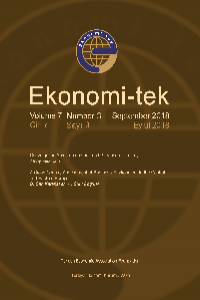Forecasting Inflation Using Summary Statistics of Survey Expectations: A Machine-Learning Approach
This paper aims to produce more accurate short-term inflation forecasts based on surveys of expectations by employing machine-learning algorithms. By treating inflation forecasting as an estimation problem consisting of a label (inflation) and features (summary statistics of surveys of expectations data), we train a suite of machine-learning models, namely, Linear Regression, Bayesian Ridge Regression, Kernel Ridge Regression, Random Forests Regression, and Support Vector Machines, to forecast the consumer-price inflation (CPI) in Turkey. We employ the Time Series Cross Validation Procedure to ensure that the training data exclude forecast horizon data. Our results indicate that these machine-learning algorithms outperform the official forecasts of the Central Bank of Turkey (CBT) and a univariate model.
Anahtar Kelimeler:
Machine learning, forecast evaluation, inflation forecasting, surveys of expectations, summary statistics
Forecasting Inflation Using Summary Statistics of Survey Expectations: A Machine-Learning Approach
This paper aims to produce more accurate short-term inflation forecasts based on surveys of expectations by employing machine-learning algorithms. By treating inflation forecasting as an estimation problem consisting of a label (inflation) and features (summary statistics of surveys of expectations data), we train a suite of machine-learning models, namely, Linear Regression, Bayesian Ridge Regression, Kernel Ridge Regression, Random Forests Regression, and Support Vector Machines, to forecast the consumer-price inflation (CPI) in Turkey. We employ the Time Series Cross Validation Procedure to ensure that the training data exclude forecast horizon data. Our results indicate that these machine-learning algorithms outperform the official forecasts of the Central Bank of Turkey (CBT) and a univariate model.
Keywords:
Machine learning, forecast evaluation, inflation forecasting, surveys of expectations, summary statistics,
___
- Altuğ, S., & C. Çakmaklı, (2016), “Forecasting Inflation Using Survey Expectations and Target Inflation: Evidence for Brazil and Turkey,” International Journal of Forecasting, 32 (1), pp. 138-153. https://doi.org/10.1016/j.ijforecast.2015.03.010
- Ang, A., Bekaert, G., & M. Wei, (2007), “Do Macro-variables, Asset Markets, or Surveys Forecast Inflation Better?” Journal of Monetary Economics, 54 (4), pp. 1163-1212. https://doi.org/10.1016/j.jmoneco.2006.04.006
- Atkeson, A., & L. E. Ohanian, (2001), “Are Phillips Curves Useful for Forecasting Inflation?” Federal Reserve Bank of Minneapolis Quarterly Review, 25 (1), pp. 2-11.
- Breiman, L., (2001), “Random Forests,” Machine Learning, 45 (1), pp. 5-32. https://doi.org/10.1023/A:1010933404324
- Gil-Alana, L., A. Moreno, & F. de Gracia, (2012), “Exploring Survey-Based Inflation Forecasts,” Journal of Forecasting, 31 (6), pp. 524-539. https://doi.org/10.1002/for.1235
- Grothe, M., & A. Meyler, (2015), “Inflation Forecasts: Are Market-based and Survey-based Measures Informative?,” European Central Bank, Working Paper No. 1865.
- Hastie, T., R. Tibshirani, & J. Friedman, (2017), The Elements of Statistical Learning: Data Mining, Inference, and Prediction, Springer.
- Hsiang, T. C., (1975), “A Bayesian View on Ridge Regression,” Journal of the Royal Statistical Society, Series D (The Statistician), 24 (4), pp. 267-268.
- James, G., D. Witten, T. Hastie, & R. Tibshirani, (2013), An Introduction to Statistical Learning, Vol. 103, ISBN 1461471389, doi:10.1007/978-1-4614-7138-7
- Kapetanios, G., V. Labhard, & S. Price, (2008), “Forecast Combination and the Bank of England’s Suite of Statistical Forecasting Models,” Economic Modeling, 25 (4), pp. 772-792. https://doi.org/10.1016/j.econmod.2007.11.004
- Livera, A. M., R. J. Hyndman, & R. D. Snyder, (2011), “Forecasting Time Series with Complex Seasonal Patterns Using Exponential Smoothing,” Journal of the American Statistical Association, 106 (496), pp. 1513-1527. https://doi.org/10.1198/jasa.2011.tm09771
- Mullainathan, S., & J. Spiess, (2017), “Machine Learning: An Applied Econometric Approach,” Journal of Economic Perspectives, 31 (2), pp. 87-106. https://doi.org/10.1257/jep.31.2.87
- Öğünç, F., K. Akdoğan, S. Baser, M. G. Chadwick, D. Ertuğ, T. Hülagü, & N. Tekatlı, (2013), “Short-term Inflation Forecasting Models for Turkey and A Forecast Combination Analysis,” Economic Modeling, 33, pp. 312-325.
- Pedregosa, F., G. Varoquaux, A. Gramfort, V. Michel, B. Thirion, O. Grisel, & E. Duchesnay, (2012), “Scikit-learn: Machine Learning in Python,” Journal of Machine Learning Research, 12, pp. 2825-2830. https://doi.org/10.1007/s13398-014-0173-7.2
- Stock, J. H., & M. W. Watson, (2007), “Why Has US Inflation Become Harder to Forecast?” Journal of Money, Credit and Banking, 39, pp. 3-33. https://doi.org/10.1111/j.1538-4616.2007.00014.x
- Vapnik, V. N., (1995), The Nature of Statistical Learning: Theory, Springer. https://doi.org/10.1109/TNN.1997.641482
- ISSN: 2146-6173
- Yayın Aralığı: Yılda 3 Sayı
- Başlangıç: 2012
- Yayıncı: Türkiye Ekonomi Kurumu Vakfı
